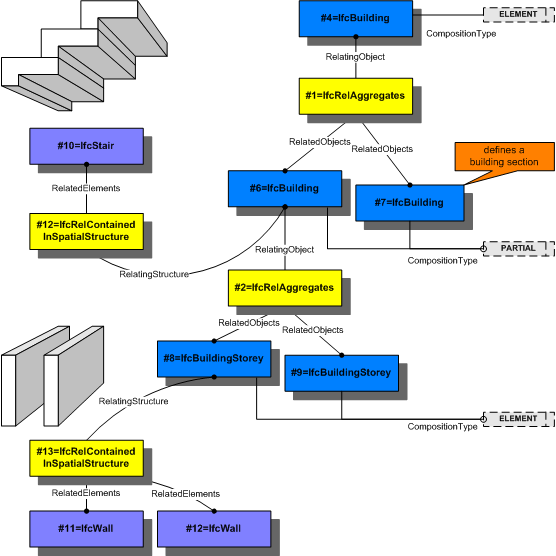Natural language names
 | Zu räumlicher Struktur zugeordnet - Relation |
 | Rel Contained In Spatial Structure |
 | Localisation dans la structure spatiale |
Change log
| Item | SPF | XML | Change | Description | IFC2x3 to IFC4 |
|---|---|---|---|---|
| IfcRelContainedInSpatialStructure | ||||
| OwnerHistory | MODIFIED | Instantiation changed to OPTIONAL. | ||
| RelatingStructure | X | X | MODIFIED | Type changed from IfcSpatialStructureElement to IfcSpatialElement. |
Semantic definitions at the entity
Entity definition
This objectified relationship, IfcRelContainedInSpatialStructure, is used to assign elements to a certain level of the spatial project structure. Any element can only be assigned once to a certain level of the spatial structure. The question, which level is relevant for which type of element, can only be answered within the context of a particular project and might vary within the various regions.
EXAMPLE A multi-storey space is contained (or belongs to) the building storey at which its ground level is, but it is referenced by all the other building storeys, in which it spans. A lift shaft might be contained by the basement, but referenced by all storeys, through which it spans.
The containment relationship of an element within a spatial structure has to be a hierarchical relationship; an element can only be contained within a single spatial structure element. The reference relationship between an element and the spatial structure need not be hierarchical; that is, an element can reference many spatial structure elements.
NOTE The reference relationship is expressed by IfcRelReferencedInSpatialStructure.
Predefined spatial structure elements to which elements can be assigned are
- site as IfcSite
- building as IfcBuilding
- storey as IfcBuildingStorey
- space as IfcSpace
Occurrences of the same element type can be assigned to different spatial structure elements depending on the context of the occurrence.
EXAMPLE A wall might be normally assigned to a storey, however the curtain wall might be assigned to the building and the retaining wall in the terrain might be assigned to the site.
Figure 166 shows the use of IfcRelContainedInSpatialStructure to assign a stair and two walls to two different levels within the spatial structure.

|
Figure 166 — Relationship for spatial structure containment |
HISTORY New entity in IFC2x.
IFC2x CHANGE The data type of the attribute RelatedElements has been changed from IfcElement to its supertype IfcProduct with upward compatibility for file based exchange.
Attribute definitions
| # | Attribute | Type | Cardinality | Description | G |
|---|---|---|---|---|---|
| 5 | RelatedElements | IfcProduct | S[1:?] |
Set of products, which are contained within this level of the spatial structure hierarchy.
IFC2x CHANGE The data type has been changed from IfcElement to IfcProduct with upward compatibility | X |
| 6 | RelatingStructure | IfcSpatialElement |
Spatial structure element, within which the element is contained. Any element can only be contained within one element of the project spatial structure.
IFC4 CHANGE The attribute RelatingStructure as been promoted to the new supertype IfcSpatialElement with upward compatibility for file based exchange. | X |
Formal Propositions
| Rule | Description |
|---|---|
| WR31 | The relationship object shall not be used to include other spatial structure elements into a spatial structure element. The hierarchy of the spatial structure is defined using IfcRelAggregates. |
Inherited definitions from supertypes
Entity inheritance

Attribute inheritance
| # | Attribute | Type | Cardinality | Description | G |
|---|---|---|---|---|---|
| IfcRoot | |||||
| 1 | GlobalId | IfcGloballyUniqueId | Assignment of a globally unique identifier within the entire software world. | X | |
| 2 | OwnerHistory | IfcOwnerHistory | ? |
Assignment of the information about the current ownership of that object, including owning actor, application, local identification and information captured about the recent changes of the object,
NOTE only the last modification in stored - either as addition, deletion or modification. IFC4 CHANGE The attribute has been changed to be OPTIONAL. | X |
| 3 | Name | IfcLabel | ? | Optional name for use by the participating software systems or users. For some subtypes of IfcRoot the insertion of the Name attribute may be required. This would be enforced by a where rule. | X |
| 4 | Description | IfcText | ? | Optional description, provided for exchanging informative comments. | X |
| IfcRelationship | |||||
| IfcRelConnects | |||||
| IfcRelContainedInSpatialStructure | |||||
| 5 | RelatedElements | IfcProduct | S[1:?] |
Set of products, which are contained within this level of the spatial structure hierarchy.
IFC2x CHANGE The data type has been changed from IfcElement to IfcProduct with upward compatibility | X |
| 6 | RelatingStructure | IfcSpatialElement |
Spatial structure element, within which the element is contained. Any element can only be contained within one element of the project spatial structure.
IFC4 CHANGE The attribute RelatingStructure as been promoted to the new supertype IfcSpatialElement with upward compatibility for file based exchange. | X | |
Definitions applying to General Usage
Concept inheritance
| # | Concept | Template | Model View |
|---|---|---|---|
| IfcRoot | |||
| Identity | Software Identity | General Usage | |
| Revision Control | Revision Control | General Usage | |
Formal representations
XML Specification
<xs:element name="IfcRelContainedInSpatialStructure" type="ifc:IfcRelContainedInSpatialStructure" substitutionGroup="ifc:IfcRelConnects" nillable="true"/>
<xs:complexType name="IfcRelContainedInSpatialStructure">
<xs:complexContent>
<xs:extension base="ifc:IfcRelConnects">
<xs:sequence>
<xs:element name="RelatedElements">
<xs:complexType>
<xs:sequence>
<xs:element ref="ifc:IfcProduct" maxOccurs="unbounded"/>
</xs:sequence>
<xs:attribute ref="ifc:itemType" fixed="ifc:IfcProduct"/>
<xs:attribute ref="ifc:cType" fixed="set"/>
<xs:attribute ref="ifc:arraySize" use="optional"/>
</xs:complexType>
</xs:element>
</xs:sequence>
</xs:extension>
</xs:complexContent>
</xs:complexType>
EXPRESS Specification
ENTITY IfcRelContainedInSpatialStructure
SUBTYPE OF (IfcRelConnects);
RelatedElements : SET [1:?] OF IfcProduct;
RelatingStructure : IfcSpatialElement;
WHERE
WR31 : SIZEOF(QUERY(temp <* RelatedElements | 'IFCPRODUCTEXTENSION.IfcSpatialStructureElement' IN TYPEOF(temp))) = 0;
END_ENTITY;
 References: IfcAnnotation
IfcElement
IfcPositioningElement
IfcSpatialElement
References: IfcAnnotation
IfcElement
IfcPositioningElement
IfcSpatialElement

 EXPRESS-G diagram
EXPRESS-G diagram Link to this page
Link to this page